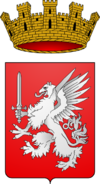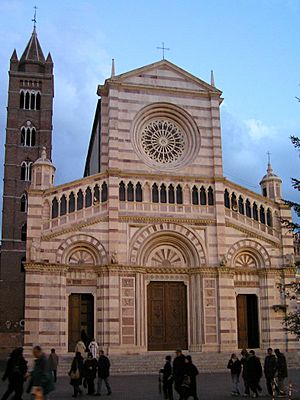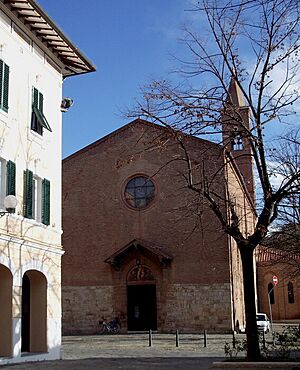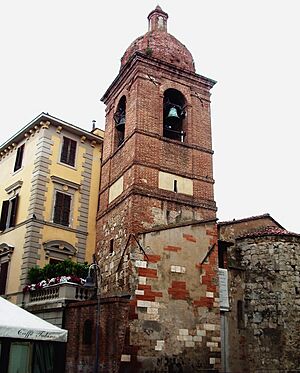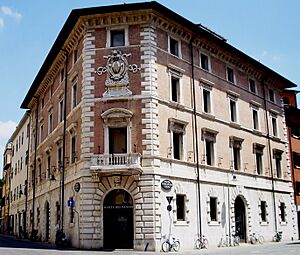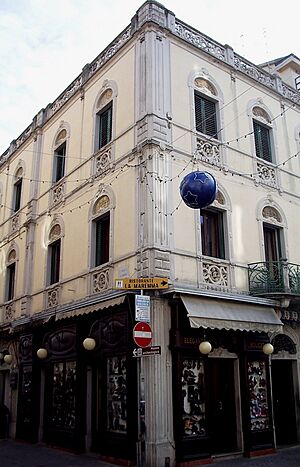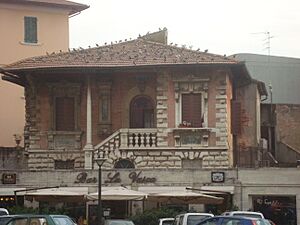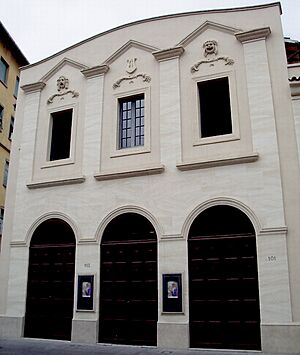Grosseto facts for kids
Quick facts for kids
Grosseto
|
|||
|---|---|---|---|
| Città di Grosseto | |||
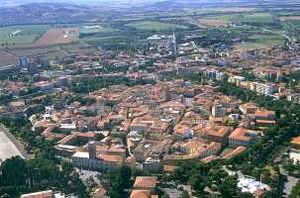
Aerial view of Grosseto
|
|||
|
|||
| Country | Italy | ||
| Region | Tuscany | ||
| Province | Grosseto (GR) | ||
| Frazioni | Alberese, Batignano, Braccagni, Istia d'Ombrone, Marina di Grosseto, Montepescali, Principina a Mare, Principina Terra, Rispescia, Roselle | ||
| Area | |||
| • Total | 474.46 km2 (183.19 sq mi) | ||
| Elevation | 10 m (30 ft) | ||
| Population
(30 November 2015)
|
|||
| • Total | 82,131 | ||
| • Density | 173.1042/km2 (448.338/sq mi) | ||
| Demonym(s) | Grossetani | ||
| Time zone | UTC+1 (CET) | ||
| • Summer (DST) | UTC+2 (CEST) | ||
| Postal code |
58100
|
||
| Dialing code | 0564 | ||
| Patron saint | St. Lawrence | ||
| Saint day | 10 August | ||
Grosseto is a city in the central Italian region of Tuscany. It is the capital of the province of Grosseto and the Maremma area. The city is about 14 kilometers (9 miles) from the Tyrrhenian Sea. It sits on a flat plain near the Ombrone river.
Grosseto is the biggest city in Maremma, with over 82,000 people living there. The area of Grosseto includes several smaller towns called frazioni. Some of these are Marina di Grosseto, Roselle, and Montepescali.
Contents
History of Grosseto
Early Beginnings
Grosseto started a long time ago, in the High Middle Ages. It was first mentioned in the year 803. Back then, it was owned by the Aldobrandeschi family. They were powerful counts who ruled the area for many years.
Growing Importance
Grosseto slowly became more important as other nearby cities like Rusellae and Vetulonia became less powerful. In 1137, German troops attacked Grosseto. They were led by Duke Heinrich X of Bavaria. The next year, the main church of the area moved its center to Grosseto.
In 1151, the people of Grosseto promised to be loyal to the Republic of Siena. Later, in 1222, the Aldobrandeschi family gave Grosseto the right to have its own leader, called a podestà. This meant the city had more control over itself.
Under Siena's Rule
However, in 1244, Siena took control of Grosseto again. From then on, Grosseto's future was linked to Siena's. It became an important fort, and you can still see its old walls and towers today.
Grosseto tried to become free from Siena in 1266 and 1355, but it didn't work. The city was attacked many times. It was even declared outside the church's rules by Pope Clement IV. Finally, Grosseto had to accept Siena's stronger rule.
Challenges and Changes
The terrible plague of 1348 hit Grosseto very hard. By 1369, its population had shrunk to only about a hundred families. The area was also often attacked by armies.
Siena's rule ended in 1559. At that time, Emperor Charles V gave the whole region to Cosimo I de Medici. He was the first grand duke of Tuscany. In 1574, new defensive walls were started. These walls are still very well preserved today. The swampy land around the city was also drained. Even with these changes, Grosseto remained a small town.
Modern Times
Under the rule of the House of Lorraine, Grosseto began to grow. It was made the capital of the new Maremma province.
In 1943, during World War II, the city was heavily bombed by the Allies. In 2024, Grosseto was chosen as the European Green Pioneer of Smart Tourism. This award recognizes cities that are leaders in sustainable tourism. Grosseto was picked from 40 other cities.
Geography
Climate
Grosseto has a Mediterranean climate. This means it has mild, wet winters and very hot, dry summers. On average, the temperature drops to freezing or below about 25 nights a year. However, there are also about 41 days a year when the temperature reaches or goes above 30°C (86°F). Fog occurs about 12 days a year.
| Climate data for Grosseto (Grosseto Airport) (1991–2020) | |||||||||||||
|---|---|---|---|---|---|---|---|---|---|---|---|---|---|
| Month | Jan | Feb | Mar | Apr | May | Jun | Jul | Aug | Sep | Oct | Nov | Dec | Year |
| Record high °C (°F) | 19.6 (67.3) |
22.8 (73.0) |
25.2 (77.4) |
29.4 (84.9) |
33.6 (92.5) |
39.0 (102.2) |
38.8 (101.8) |
40.2 (104.4) |
35.0 (95.0) |
30.6 (87.1) |
27.0 (80.6) |
20.0 (68.0) |
40.2 (104.4) |
| Mean daily maximum °C (°F) | 12.8 (55.0) |
13.7 (56.7) |
16.4 (61.5) |
19.4 (66.9) |
23.8 (74.8) |
28.4 (83.1) |
31.4 (88.5) |
31.8 (89.2) |
27.2 (81.0) |
22.5 (72.5) |
17.1 (62.8) |
13.4 (56.1) |
21.5 (70.7) |
| Daily mean °C (°F) | 7.5 (45.5) |
7.9 (46.2) |
10.5 (50.9) |
13.3 (55.9) |
17.6 (63.7) |
22.0 (71.6) |
24.9 (76.8) |
25.1 (77.2) |
20.9 (69.6) |
16.8 (62.2) |
12.1 (53.8) |
8.3 (46.9) |
15.6 (60.1) |
| Mean daily minimum °C (°F) | 2.9 (37.2) |
2.6 (36.7) |
4.8 (40.6) |
7.3 (45.1) |
11.2 (52.2) |
15.0 (59.0) |
17.8 (64.0) |
18.4 (65.1) |
15.2 (59.4) |
11.8 (53.2) |
7.7 (45.9) |
3.9 (39.0) |
9.9 (49.8) |
| Record low °C (°F) | −8.2 (17.2) |
−13.0 (8.6) |
−5.6 (21.9) |
−2.6 (27.3) |
1.6 (34.9) |
6.8 (44.2) |
8.8 (47.8) |
10.6 (51.1) |
5.8 (42.4) |
1.4 (34.5) |
−4.6 (23.7) |
−10.1 (13.8) |
−13.0 (8.6) |
| Average precipitation mm (inches) | 41.38 (1.63) |
36.86 (1.45) |
39.39 (1.55) |
38.84 (1.53) |
39.66 (1.56) |
23.14 (0.91) |
14.95 (0.59) |
29.95 (1.18) |
62.71 (2.47) |
58.43 (2.30) |
99.39 (3.91) |
69.16 (2.72) |
553.86 (21.81) |
| Average precipitation days (≥ 1.0 mm) | 5.34 | 5.00 | 5.86 | 5.73 | 5.20 | 2.87 | 1.60 | 2.03 | 4.77 | 6.28 | 9.07 | 7.90 | 61.65 |
| Average relative humidity (%) | 73.22 | 69.57 | 69.03 | 69.83 | 68.07 | 65.30 | 63.47 | 64.22 | 67.35 | 73.05 | 75.79 | 74.22 | 69.43 |
| Average dew point °C (°F) | 3.34 (38.01) |
2.93 (37.27) |
5.22 (41.40) |
8.17 (46.71) |
11.66 (52.99) |
14.77 (58.59) |
16.71 (62.08) |
17.56 (63.61) |
14.81 (58.66) |
12.44 (54.39) |
8.47 (47.25) |
4.40 (39.92) |
10.04 (50.07) |
| Source: NOAA | |||||||||||||
Culture
Language and Literature
The main language spoken in Grosseto is Tuscan Italian.
Andrea da Grosseto was born in Grosseto in the 1200s. He is very important in Italian literature. He is thought to be the first writer to use the Italian language in a formal way. In 1268, Andrea da Grosseto translated some Latin texts into Italian. He wanted to use a general "Italian national language" that everyone could understand, not just his local dialect.
Museums to Visit
Grosseto has several interesting museums:
- Museo archeologico e d'arte della Maremma: This museum focuses on archaeology and art from the Maremma region.
- Museo di storia naturale della Maremma: Here you can learn about the natural history of Maremma.
- Museo Collezione Gianfranco Luzzetti: This museum displays a collection of art.
Grosseto in Movies
Grosseto and the Maremma area have been used as settings for many movies. Some famous films include The Easy Life (1962), Nothing Left to Do But Cry (1984) with Roberto Benigni, and The Talented Mr. Ripley. Famous Italian actors like Elsa Martinelli and Luigi Pistilli were born in Grosseto.
Local Cuisine
When you visit Grosseto, you might try some local breads. Schiaccia alla pala is an oven-baked bread with oil. Schiaccia con cipolle e acciughe is the same bread but with onions and anchovies.
Acquacotta is a simple soup from the Mount Amiata area. It's made with vegetables like artichokes, broccoli, cabbage, and beans. The famous florentine steak is often made from Maremmana cattle, which are raised in this region.
Main Sights
The Medicean Walls
The walls around Grosseto were built starting in 1564. They were ordered by Cosimo I de Medici. He wanted to make Grosseto a strong fortress to protect his southern border. The walls were designed by Baldassarre Lanci. Until 1757, there was a ditch around the outside. There were two main gates: Porta Nuova in the north and Porta Reale (now called Porta Vecchia) in the south.
Today, these walls are a popular public park and a great place for walking.
Religious Buildings
The Cathedral
The main church in Grosseto is the Romanesque cathedral. It is named after its patron saint, St. Lawrence. Building started in the late 1200s but wasn't finished until the 1400s because of fights with Siena.
The front of the cathedral has alternating layers of white and black marble. This style is called Romanesque. Most of what you see today is from repairs done in the 1500s and early 1800s. Inside, the church has a main area (nave) and two side areas (aisles). Important artworks include a carved baptismal font from the 1470s and the Madonna delle Grazie painting by Matteo di Giovanni. The bell tower was finished in 1402.
Churches in the City Center
- Church of San Francesco: This church was built in the 1200s. It was first a Benedictine, then a Franciscan, convent. It has been rebuilt several times. A special wooden structure stands at the front. Inside, you can see art from different time periods. In the middle of the courtyard, there is a unique well called Pozzo della Bufala (Well of the Buffalo).
- Convent of Clarisse: This old convent and its church, the Church of Bigi, are no longer used for religious services. They have medieval origins but were rebuilt in the 1600s in the Baroque style. Today, the convent houses a museum and the university.
- Church of San Pietro: This is the oldest religious building in Grosseto. It was built along the old Roman road, the Via Aurelia.
- Church of Misericordia: Built in the 1800s, this church now belongs to a brotherhood. Many of its old artworks are now in the Archaeological and Art Museum of Maremma.
Churches Outside the City Walls
- Basilica of Sacro Cuore di Gesù: This church was built in 1958. It is a minor basilica, which is a special title given by the Pope.
- Church of Medaglia Miracolosa: Built in the early 1900s, this church has a neo-Romanesque style and a bell tower.
- Church of San Giuseppe: Located in the western part of the city, this church was built in the 1930s in a Romanesque Revival style.
- Church of San Giuseppe Benedetto Cottolengo: This church was built in the mid-1900s in a Romanesque Revival style.
- Maria Santissima Addolorata: A modern church built in the 1970s.
- Santissimo Crocifisso: A modern church for the people living in the Porta Vecchia area.
- Santa Lucia: A modern church in the Barbanella neighborhood.
- Church of Santa Famiglia: Located in the Sugherella neighborhood.
- Santa Teresa: Consecrated in 2018, this church is in the northern part of the city.
Old Abbeys
- Abbey of San Rabano: This abbey is in the Natural Park of Maremma. It was built in the Middle Ages as a monastery. It was later used by the Knights of Jerusalem before being abandoned in the 1500s.
- Abbey of San Pancrazio al Fango: This ruined church is located between Grosseto and Castiglione della Pescaia. It was built in the Middle Ages on a small hill overlooking wetlands.
Other Buildings and Monuments
Palaces and Public Buildings
Inside the city walls, you can find:
- Palazzo Aldobrandeschi: A beautiful building in the Gothic Revival style. It is the seat of the Province of Grosseto.
- Palazzo Comunale (Town Hall): Built between 1870 and 1873, it is next to the Cathedral.
- Episcopal Palace: This building houses the offices of the Roman Catholic Diocese of Grosseto.
- Palazzo Monte dei Paschi: A palace in the Renaissance Revival style.
- Grand Hotel Bastiani: Another Renaissance Revival style building.
- Palazzo del Genio Civile: Built in the early 1900s, it has nice ceramic decorations.
- Palazzo Tognetti: An Art Nouveau style building on Corso Carducci.
- Palazzo Moschini: This building holds the Grosseto State Archives.
- Palazzo Mensini: Built in 1898, it is home to the Chelliana Library.
- Cassero del Sale: Built in the 1200s to store salt collected from the coast.
- Casa del Fascio: Built during the Fascism period for the local Fascist Party.
- Grosseto Prison: A jailhouse from the 1800s.
Outside the city walls, you can find:
- Villino Pastorelli: A Gothic Revival villa built between 1908 and 1913.
- Villino Panichi: An Art Nouveau villa built in 1900.
- Palazzo delle Poste (Post Office): Designed in 1930, it is an example of Fascist architecture.
- Palazzo del Governo: Designed in 1927.
Theatres
- Teatro degli Industri: Located on Via Mazzini, this theatre was built in the 1800s. It is an important cultural spot in Grosseto.
- Teatro Moderno: A modern theatre outside the city walls.
Monuments and Statues
- Canapone Monument: A statue dedicated to Grand Duke Leopold II of Lorraine. It is in the center of Piazza Dante.
- Roman column: This column is at the Cathedral. It was brought from nearby Roselle in the Middle Ages.
- Unknown Soldier Monument: Built in 1921, this monument honors the soldiers who died in World War I and World War II.
- Andrea da Grosseto Monument: This statue, made in the 1970s, honors Andrea da Grosseto, the scholar who first used Italian literary prose.
- Well of Spedale: A well from the 1400s in Piazza San Francesco.
- Well of Buffalo: Located in the courtyard of San Francesco, built by the Medici family.
- Well of Fortezza: Inside the Fortezza bastion, built in the 1500s to supply water to guards.
Other Interesting Places
- The Etruscan site of Roselle: An ancient city site with ruins to explore.
- Medieval buildings in the frazioni of Batignano, Istia d'Ombrone and Montepescali.
- Granducal villa of Alberese: Built in the 1400s, it was once a residence for the Grand Dukes of Tuscany.
Sports
Grosseto has a strong tradition in sports. Baseball and football (soccer) are very popular. Other sports like American football, cricket, horse racing, and athletics are also widely played.
Baseball
The main men's baseball team in Grosseto is called Bbc Grosseto Orioles. They play in Italy's top league, Serie A1. They have won the national championship several times (1986, 1989, 2004, 2007) and the European Cup in 2005. They play their home games at Stadio Roberto Jannella.
Football (Soccer)
The Unione Sportiva Grosseto Football Club was started in 1912. They have played in Serie B, which is the second level of Italian soccer leagues, since the 2007–2008 season. The team plays its games at the Stadio Carlo Zecchini.
Other Sports
Other important teams include the Maremma Cricket Club and American Football Condor Grosseto.
Horse racing is also very important, with many races throughout the year, especially at night in the summer. These races take place at the hippodrome Casalone.
Grosseto is also a major center for athletics. The Stadio Carlo Zecchini has hosted big events like the European Athletics Junior Championships in 2001 and the IAAF World Junior Championships in Athletics in 2004. In 2006, Grosseto also hosted the World Military Fencing Championships.
Transportation
Trains
Grosseto is connected by the Pisa-Livorno-Rome railway line. This line links Genoa to Rome. Grosseto is also the end point for trains coming from Siena.
Here are the train stations in Grosseto:
- Grosseto Station: This is the main station for the city center.
- Montepescali Station: Located north of the city, where the lines to Pisa and Siena split.
- Alberese Station: Located south of the city, but since 2010, it's only served by buses.
- Rispescia Station: This station is no longer used.
Buses
Local bus service in Grosseto is run by Autolinee Toscane. Intercity buses leave from the main bus station in Piazza Marconi. There are also bus services to Florence, Siena, and other cities in Tuscany. A network of city bus routes also operates in Grosseto.
Port
Grosseto has a modern tourist port that opened in 2004. It is located in the seaside town of Marina di Grosseto. For longer trips, the main port is Porto Santo Stefano (about 40 km away). From there, you can take ferries to the islands of Giglio and Giannutri.
Airport
Grosseto and the Maremma area are served by Grosseto Baccarini Airport. This airport is used by the military but also handles civilian charter flights and private planes.
For regular domestic and international flights, people usually use the airports in Florence, Pisa, and Rome-Fiumicino. All three are about 150 km (93 miles) from Grosseto.
Notable People from Grosseto
- Andrea da Grosseto (13th century), a writer and translator.
- Luciano Bianciardi (1922–1971), a novelist.
- Jessica Brando (1994–), a singer.
- Carlo Cassola (1917–1987), a novelist who lived in Grosseto for many years.
- Elsa Martinelli (1935-2017), a famous actress.
- Luigi Pistilli (1929–1996), an actor.
- Alessandra Sensini (1970–), a windsurfer who won four Olympic medals.
Sister Cities
Grosseto is twinned with several cities around the world. This means they have special friendly relationships.
 Birkirkara, Malta
Birkirkara, Malta Cottbus, Germany
Cottbus, Germany Dimitrovgrad, Bulgaria
Dimitrovgrad, Bulgaria Kashiwara, Japan
Kashiwara, Japan Montreuil, France
Montreuil, France Narbonne, France
Narbonne, France Saintes-Maries-de-la-Mer, France
Saintes-Maries-de-la-Mer, France
See also
 In Spanish: Grosseto para niños
In Spanish: Grosseto para niños



